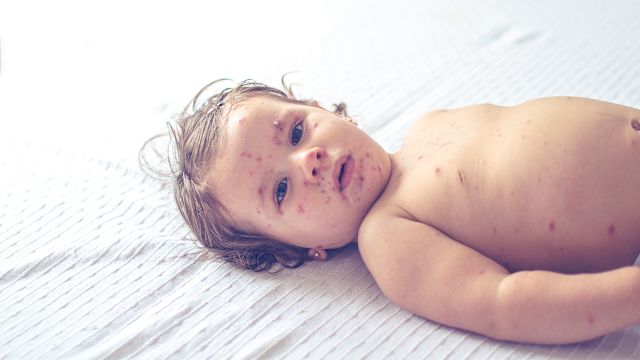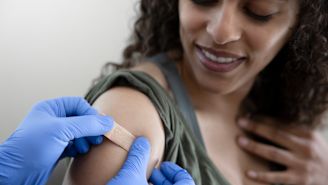Updated on October 17, 2025.
As of October 14, 2025, a total of 1,596 measles cases have been confirmed across the United States, according to the Centers for Disease Control and Prevention (CDC). It’s the worst measles outbreak since 1992 when there were 2,126 confirmed cases.
So far this year, there were three confirmed measles deaths—the first in 10 years. And overall, at least 92 percent of those infected are unvaccinated, and another 4 percent are only partially vaccinated (they received one dose of the two-dose vaccine that protects against measles.)
In the United States, there are vaccines that protect against 30 different diseases. But after decades of progress, childhood vaccination rates have been falling in the United States. The decline predates COVID, but the pandemic and disruptions in routine healthcare contributed to the downward trend.
Nearly all vaccinations among U.S. children born in 2020 and 2021 are up to 7.8 percent lower than vaccinations among children born in 2018 and 2019, according to a September 2024 CDC report. And when looking at just the MMR vaccine, which protects against measles, mumps, and rubella, immunization rates are falling below the threshold needed to keep measles from spreading.
At least 95 percent of the population must be vaccinated against measles to effectively stop the spread of the virus. But only 90.8 percent of children receive the two-dose MMR vaccination by the time they are 2 years old. During the 2024-25 school year, coverage for a range of vaccines, including measles, mumps, and rubella (MMR), diphtheria, tetanus, and pertussis (DTaP), polio, and varicella decreased among kindergartners. The MMR vaccination rate for this age group was just 92.5 percent, according to the Johns Hopkins Bloomberg School of Public Health. And just 91.9 percent of teens ages 13 to 17 are fully vaccinated against measles, mumps, rubella, the CDC reports.
Is measles really back—and can we stop it?
In the U.S., thanks to widespread, routine childhood vaccination with the MMR (measles, mumps, rubella) vaccine since 1971, measles was declared eliminated in 2000. Elimination, however, is not the same as eradication. The virus that causes measles is still around and will spread if given the opportunity—and that’s what’s happening.
In the U.S., misinformation about vaccines and fears about a link between the MMR shot and autism (which stem from a falsified report that was retracted and discredited decades ago) are lowering vaccination rates. The fact that the U.S. vaccination program has been so successful—and made once common diseases, like smallpox and polio, rare—may also give people a false sense of security, or the idea that they don’t exist anymore. But they do.
“People look around and say, ‘We don’t see these diseases. Why should we vaccinate against them?’” says Nathan Lo, MD, PhD, assistant professor of infectious diseases at Standford University in a news release “There’s a general fatigue with vaccines. And there’s distrust and misinformation about vaccine effectiveness and safety.”
Dr. Lo and a team of researchers at Stanford used a large-scale epidemiological model to simulate the spread of infectious diseases in the United States at various childhood vaccination levels. The results of their study, which were published in April 2025 in JAMA, found that if vaccination rates remain at current levels, measles could become endemic (always around) in the U.S. again with an estimated 851,300 cases over the next 25 years. This would lead to some 170,200 hospitalizations and 2,550 deaths.
With declines in vaccination, this could happen more quickly, the researchers noted. For example, if vaccination fell by 10 percent (from about 90 to 80 percent), they predict that measles cases would surge to 11.1 million over the next 25 years.
And if vaccinations rates were cut in half, measles would become endemic in five years, rubella would become endemic within 20 years, and polio would also become endemic in about 20 years. Under this grim scenario, the study also estimates that over the next 25 years the U.S. could expect:
- 51.2 million cases of measles
- 9.9 million cases of rubella
- 4.3 million cases of polio
- 200 cases of diphtheria
These infections would result in:
- 10.3 million hospitalizations
- 159,200 deaths
- An estimated 51,200 children with post-measles neurological complications
- 10,700 cases of birth defects due to rubella
- 5,400 people paralyzed from polio
“Right now, so many people are immune through vaccination that diseases don’t spread far. But if vaccinations decline over a longer period, you start to see outbreaks increase in size and frequency,” explained Dr. Lo, who is the study’s senior author. “Eventually you see sustained, ongoing transmission, meaning these diseases become endemic — they become household names once again.”
The researchers also caution that if decades of progress is undone—and if diseases like measles, rubella, and polio become endemic again—it would take years to correct.
“If that were to happen, you can’t just flip a switch — once these diseases get unleashed, it would take time to eliminate them again,” Lo explained. The authors noted, however, that even small increases in U.S. vaccination rates could help prevent this from happening.
But is the MMR vaccine safe?
The short answer to this question: Yes.
The MMR vaccine is given in two shots, the first at age 12 to 15 months, the second between the ages of 4 and 6 -years old. Study after study has shown that this vaccine is very safe and effective—and it and does not cause autism in children who receive it.
In 2011, an Institute of Medicine (IOM) report, which examined eight vaccines given to both kids and adults, found that they are very safe. In 2013, a CDC study examined the immune response to the vaccine in children during the first two years of life. They found no differences between kids with autism and those who did not have this condition.
A March 2019 study published in the Annals of Internal Medicine, analyzed the safety of the MMR vaccine even more rigorously. Researchers in Denmark used larger populations of children (for more statistical power) to investigate concerns about a link between the vaccine and autism. They also included a larger number of children considered at high-risk for autism to address the specific claim that the MMR vaccines may be more dangerous for these kids, in particular.
The scientists evaluated whether the MMR vaccine increased the risk of autism in 657,461 children born in Denmark between 1999 and 2010. They tracked the kids until August 2013, documenting diagnoses of autism spectrum disorders and risk factors for these conditions, including parents’ ages, siblings with autism, method of delivery, smoking during pregnancy, preterm birth, and low birth weight.
The study found no evidence of a link between the MMR vaccine and autism or an increased risk for these disorders—even among high-risk kids.
A more recent 2020 review of existing studies publish in Frontiers in Microbiology also found no causal link between the MMR vaccine and autism—or autoimmune disease or a weakened immune system for that matter. The researchers warned, however, that the misinformation surrounding vaccine safety does pose a threat to children’s lives around the world. They emphasized that life-saving vaccines are the reason why most people do not have first-hand experience of the devastating consequences of many vaccine-preventable diseases.
Kids who miss out on routine immunization are at risk for many vaccine-preventable diseases, including diphtheria, tetanus, pertussis, and varicella (chicken pox).
“This means every year children get severe illnesses and possibly even die from diseases that could have been prevented by a vaccine,” says Anthony Komaroff, MD, Distinguished Simcox-Clifford-Higby Professor of Medicine at Harvard Medical School and Senior Physician at Brigham and Women's Hospital in Boston, noting that “all vaccines are carefully studied before they are licensed for routine use.”
Yes, measles can be dangerous—even deadly
The most common side effects of the MMR include mild rash, fever, or temporary discomfort in the arm where the shot was given. By comparison, getting measles is far worse and more serious. Measles is a highly contagious respiratory illness that can cause severe complications. One in five cases requires hospitalization, and about three in every 1,000 cases is deadly.
Measles symptoms usually appear seven to 14 days after exposure. But they are considered contagious four days before they show signs of infection.
An infected person will develop a fever and fatigue. Before long, they will start to cough and get a runny nose. They may also have conjunctivitis, also known as pinkeye.
About two days after these symptoms appear, tiny white spots, called Koplik spots, may form inside their mouth. Three to five days after symptoms begin, patients will break out in the characteristic red measles rash. First, it will appear on their face before spreading to their chest, arms, legs, and feet. At this point, their fever may spike to more than 104 degrees Fahrenheit.
Those infected may continue to be contagious or spread the virus to others for four days after the rash appears.
Measles can also cause ear infections, diarrhea, and pneumonia. More rarely, it can lead to encephalitis (inflammation of the brain), which may be fatal. This risk for serious complications or death resulting from a measles infection is greater for infants than young children or adults.
There is no way to cure measles once someone is infected. Treatment involves managing symptoms and trying to prevent complications.







